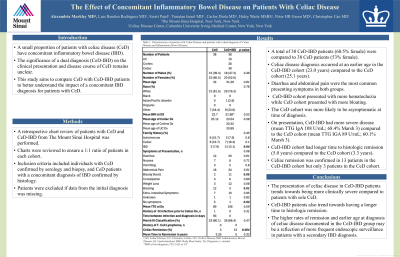Tuesday Poster Session
Category: Small Intestine
P4933 - The Effect of Concomitant Inflammatory Bowel Disease on Patients With Celiac Disease
Tuesday, October 29, 2024
10:30 AM - 4:00 PM ET
Location: Exhibit Hall E


Alexandria Markley, MD
Mount Sinai West, Icahn School of Medicine at Mount Sinai
New York, NY
Presenting Author(s)
Alexandria Markley, MD1, Luis Rendon, MD2, Swati Patel, MD1, Yontan Israel, MD3, Carlos Diola, MD4, Peter Green, MD5, Haley Waite, MS6, Christopher Cao, MD4
1Mount Sinai West, Icahn School of Medicine at Mount Sinai, New York, NY; 2Mount Sinai Beth Israel, Icahn School of Medicine at Mount Sinai, New York, NY; 3Ichan School of Medicine at Mount Sinai, New York, NY; 4Icahn School of Medicine at Mount Sinai, New York, NY; 5New York-Presbyterian/Columbia University Irving Medical Center, New York, NY; 6Mount Sinai Health System, New York, NY
Introduction: A small proportion of patients with celiac disease (CeD) have concomitant inflammatory bowel disease (IBD), and the significance of a dual diagnosis (CeD-IBD) on the clinical presentation and disease course of CeD remains unclear. This study aims to compare CeD with CeD-IBD patients to better understand the impact of a concomitant IBD diagnosis for patients with CeD.
Methods: A retrospective chart review of patients with CeD and CeD-IBD from The Mount Sinai Hospital was performed. Charts were reviewed to ensure a 1:1 ratio of patients in each cohort. Inclusion criteria included individuals with CeD confirmed by serology and biopsy and CeD patients with a concomitant diagnosis of IBD confirmed by histology. Patients were excluded if data from the initial diagnosis was missing.
Results: A total of 38 CeD-IBD patients (60.5% female) were compared to 38 CeD patients (53% female). Celiac disease diagnosis occurred at an earlier age in the CeD-IBD cohort (23.0 years) compared to the CeD cohort (25.1 years). Diarrhea and abdominal pain were the most common presenting symptoms in both groups; CeD-IBD cohort presented with more hematochezia while CeD cohort presented with more bloating. The CeD cohort was more likely to be asymptomatic at time of diagnosis. On presentation, CeD-IBD had more severe disease (mean TTG IgA 108 U/mL; 68.4% Marsh 3) compared to the CeD cohort (mean TTG IGA 89 U/mL; 60.1% Marsh 3). CeD-IBD cohort had longer time to histologic remission (5.0 years) compared to the CeD cohort (3.3 years). Celiac remission was confirmed in 13 patients in the CeD-IBD cohort but only 3 patients in the CeD cohort. Enteropathy associated T-cell lymphoma was not seen in either cohort.
Discussion: The presentation of celiac disease in CeD-IBD patients trends towards being more clinically severe compared to patients with sole CeD. CeD-IBD patients also trend towards having a longer time to histologic remission. The higher rates of remission and earlier age at diagnosis of celiac disease documented in the CeD-IBD group may be a reflection of more frequent endoscopic surveillance in patients with a secondary IBD diagnosis.
Note: The table for this abstract can be viewed in the ePoster Gallery section of the ACG 2024 ePoster Site or in The American Journal of Gastroenterology's abstract supplement issue, both of which will be available starting October 27, 2024.
Disclosures:
Alexandria Markley, MD1, Luis Rendon, MD2, Swati Patel, MD1, Yontan Israel, MD3, Carlos Diola, MD4, Peter Green, MD5, Haley Waite, MS6, Christopher Cao, MD4. P4933 - The Effect of Concomitant Inflammatory Bowel Disease on Patients With Celiac Disease, ACG 2024 Annual Scientific Meeting Abstracts. Philadelphia, PA: American College of Gastroenterology.
1Mount Sinai West, Icahn School of Medicine at Mount Sinai, New York, NY; 2Mount Sinai Beth Israel, Icahn School of Medicine at Mount Sinai, New York, NY; 3Ichan School of Medicine at Mount Sinai, New York, NY; 4Icahn School of Medicine at Mount Sinai, New York, NY; 5New York-Presbyterian/Columbia University Irving Medical Center, New York, NY; 6Mount Sinai Health System, New York, NY
Introduction: A small proportion of patients with celiac disease (CeD) have concomitant inflammatory bowel disease (IBD), and the significance of a dual diagnosis (CeD-IBD) on the clinical presentation and disease course of CeD remains unclear. This study aims to compare CeD with CeD-IBD patients to better understand the impact of a concomitant IBD diagnosis for patients with CeD.
Methods: A retrospective chart review of patients with CeD and CeD-IBD from The Mount Sinai Hospital was performed. Charts were reviewed to ensure a 1:1 ratio of patients in each cohort. Inclusion criteria included individuals with CeD confirmed by serology and biopsy and CeD patients with a concomitant diagnosis of IBD confirmed by histology. Patients were excluded if data from the initial diagnosis was missing.
Results: A total of 38 CeD-IBD patients (60.5% female) were compared to 38 CeD patients (53% female). Celiac disease diagnosis occurred at an earlier age in the CeD-IBD cohort (23.0 years) compared to the CeD cohort (25.1 years). Diarrhea and abdominal pain were the most common presenting symptoms in both groups; CeD-IBD cohort presented with more hematochezia while CeD cohort presented with more bloating. The CeD cohort was more likely to be asymptomatic at time of diagnosis. On presentation, CeD-IBD had more severe disease (mean TTG IgA 108 U/mL; 68.4% Marsh 3) compared to the CeD cohort (mean TTG IGA 89 U/mL; 60.1% Marsh 3). CeD-IBD cohort had longer time to histologic remission (5.0 years) compared to the CeD cohort (3.3 years). Celiac remission was confirmed in 13 patients in the CeD-IBD cohort but only 3 patients in the CeD cohort. Enteropathy associated T-cell lymphoma was not seen in either cohort.
Discussion: The presentation of celiac disease in CeD-IBD patients trends towards being more clinically severe compared to patients with sole CeD. CeD-IBD patients also trend towards having a longer time to histologic remission. The higher rates of remission and earlier age at diagnosis of celiac disease documented in the CeD-IBD group may be a reflection of more frequent endoscopic surveillance in patients with a secondary IBD diagnosis.
Note: The table for this abstract can be viewed in the ePoster Gallery section of the ACG 2024 ePoster Site or in The American Journal of Gastroenterology's abstract supplement issue, both of which will be available starting October 27, 2024.
Disclosures:
Alexandria Markley indicated no relevant financial relationships.
Luis Rendon indicated no relevant financial relationships.
Swati Patel indicated no relevant financial relationships.
Yontan Israel indicated no relevant financial relationships.
Carlos Diola indicated no relevant financial relationships.
Peter Green indicated no relevant financial relationships.
Haley Waite indicated no relevant financial relationships.
Christopher Cao indicated no relevant financial relationships.
Alexandria Markley, MD1, Luis Rendon, MD2, Swati Patel, MD1, Yontan Israel, MD3, Carlos Diola, MD4, Peter Green, MD5, Haley Waite, MS6, Christopher Cao, MD4. P4933 - The Effect of Concomitant Inflammatory Bowel Disease on Patients With Celiac Disease, ACG 2024 Annual Scientific Meeting Abstracts. Philadelphia, PA: American College of Gastroenterology.
